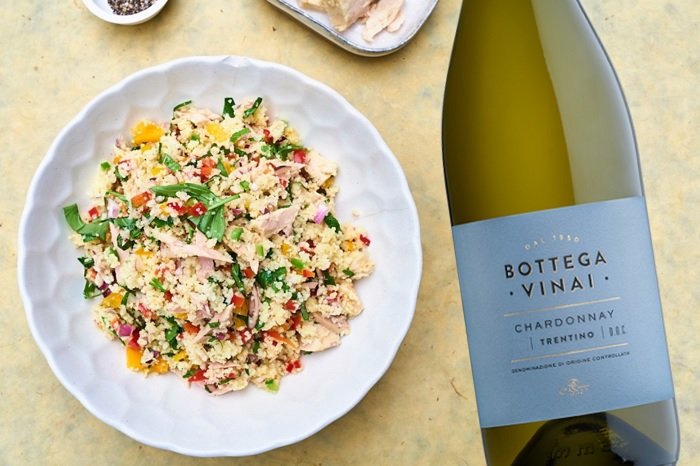Couscous is a very tasty dish and, in the precooked version, very quick to prepare. We pair it with Trentino Chardonnay Bottega Vinai 2024 Cavit.
Cous cous is derived from the processing of durum wheat, the same grain used to make pasta, and is a very versatile source of complex carbohydrates. Whole-grain cous cous is preferred.
This recipe is inspired by a dish by Chef Bart van Olphen, adapted to meet the guidelines Smartfood, the program in nutrition science and communication at the European Institute of Oncology in Milan, Italy (IEO).
Ingredients for 2 persons:
1 can of MSC*-certified tuna in extra virgin olive oil (drained weight 100 g); 160 g whole wheat cous cous; Extra virgin olive oil; Pepper; Juice of a ¼ lemon; 1 cleaned, seedless bell pepper diced; 1 red onion, sliced; 8 coarsely chopped basil leaves; 2 coarsely chopped parsley sprigs; 10 coarsely chopped mint leaves
Proceedings
Bring 320 g of water to a boil, pour it over the cous cous placed in a bowl with a tablespoon of oil and let it sit covered for about 10 minutes. Let it cool and break it up with a fork to shell it.
Season with a few tablespoons of extra virgin olive oil, lemon juice and pepper.
Add the bell bell pepper, red onion, and tuna. Stir in some of the leaves of the coarsely chopped aromatic herbs.
Use the remaining herbs to garnish the salad.
*MSC (Marine Stewardship Council) is an international non-profit organization established to address the problem of unsustainable fishing with the aim of ensuring the supply of seafood for the future as well.
 Wine pairing:
Wine pairing:
(Edited by Stefania Vinciguerra)
Trentino Chardonnay Bottega Vinai 2024 Cavit
Light straw yellow with slight greenish hints. Fragrant, fruity and varietal aromas, with notes of yellow plum, white peach, pineapple and wild flowers. Fresh and composed palate, with good body, excellent drinkability and fair length.
Production area: The hills of Santa Margherita di Ala in Vallagarina and the Valle dei Laghi north of Lake Garda. In the Santa Margherita area, vineyards are located on ancient conoids with brown, shallow, skeleton-rich soils with a loamy-clay matrix. In the Valle dei Laghi, on the other hand, medium-deep, alluvial-derived, skeleton-rich soils with a loamy-gravelly matrix are found. The two areas enjoy the same sub-Mediterranean type climate.
Grape varieties: 100% Chardonnay, with unit yields of 70 hl/ha.
Harvest: Grapes harvested by hand when perfectly ripe.
Production processes: the grapes are brought to the winery to be immediately crushed and destemmed. The must and skins are cooled to a low temperature and remain in contact with each other for about five hours to allow the best extraction of aromas. The grape processing phase continues with a soft pressing of the pulp and skins to obtain the must, which will be fermented, part in barriques and part in stainless steel. After aging on the lees (30 percent in French oak barrels and 70 percent in stainless steel), the wine is cold bottled and allowed to age in bottle before release.
Alcohol content: 13% vol.
Serving temperature: 12-14°C
Recommended pairings: salmon, mushroom risotto, spaghetti allo scoglio, baked seafood.






